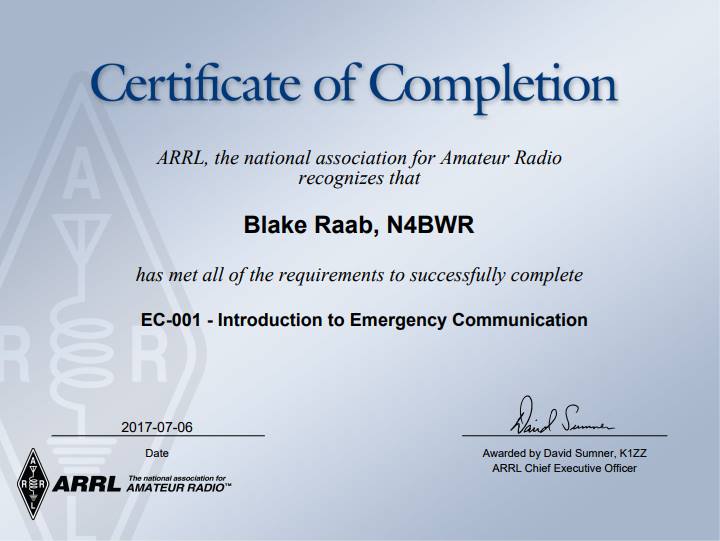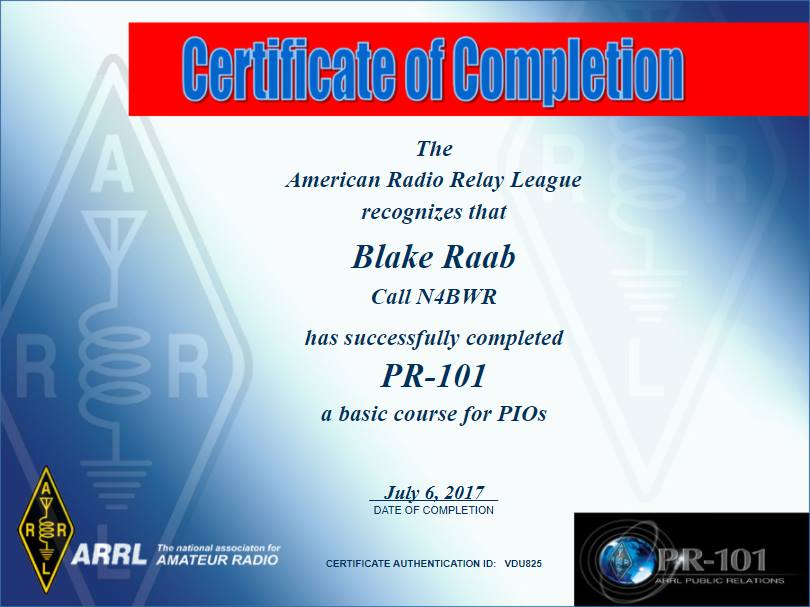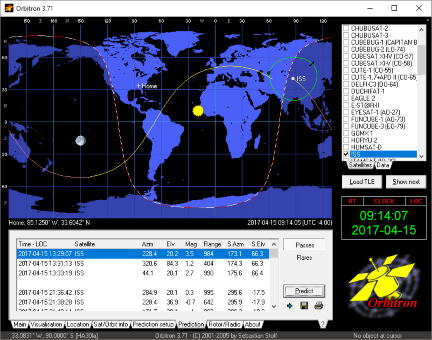- Details
- Written by: Blake Raab (N4BWR)
- Category: EmComm/Disaster Relief
I have just completed the ARRL's EC-001, Introduction to Emergency Communication course as well as EC-015 (or PR-101), the public relations course. I would highly recommend EC-001 for any amateur radio operator who wants to get involved with ARES and emergency communications. The course was made infinitely more valuable by the presence of my assigned mentor, N3KRX. He did not just put a check mark on my assignments and move on. As someone with extensive experience and training in the field, he responded to each of my assignments with lengthy (and much appreciated) emails clarifying points in the lesson, getting into more depth, and showing me real world examples of how it applies. He even talked with me about some of my experiences to make things that much more relatable.
 |
 |
- Details
- Written by: Blake Raab (N4BWR)
- Category: EmComm/Disaster Relief
For anyone coming here to find the recordings of the Carroll County ARES nets, you can find the link, called "Recorded Carroll County ARES Nets" under the EmComm Links section on the left, or click here.

- Details
- Written by: Blake Raab (N4BWR)
- Category: EmComm/Disaster Relief
- IS-1 - Emergency Program Manager: An Orientation to the Position
- IS-3 - Radiological Emergency Management
- IS-10 - Animals in Disaster: Awareness and Preparedness
- IS-11.a - Animals in Disaster: Community Planning
- IS-15.b - Special Events Contingency Planning for Public Safety Agencies
- IS-20.17 - Diversity Awareness
- IS-21.17 - Civil Rights and FEMA Disaster Assistance
- IS-22 - Are You Ready? An In-depth Guide to Citizen Preparedness
- IS-29 - Public Information Officer Awareness
- IS-35.17 - FEMA Safety Orientation 2017
- IS-36 - Multihazard Planning for Childcare
- IS-42 - Social Media in Emergency Management
- IS-55.a - Household Hazardous Materials: A Guide for Citizens
- IS-60 - Intro and Overview - Homeland Security Geospatial Concepts-of-Operations (GeoCONOPS)
- IS-61.b - The Homeland Security Geospatial Concept-of-Operations (GeoCONOPS) In Depth
- IS-62 - The Homeland Security Geospatial Concept-of-Operations GeoCONOPS) In Use
- IS-66 - Preparing the Nation for Space Weather Events
- IS-100 - Introduction to the Incident Command System
- IS-100.c - Introduction to the Incident Command System
- IS-100.FDA - Introduction to the Incident Command System for Food and Drug Administration
- IS-100.FWa - Introduction to the Incident Command System for Federal Workers
- IS-100.HCb - Introduction to the Incident Command System for Healthcare/Hospitals
- IS-100.HE - Introduction to the Incident Command System for Higher Education
- IS-100.LEb - Introduction to the Incident Command System for Law Enforcement
- IS-100.PWb - Introduction to the Incident Command System for Public Works
- IS-100.SCa - Introduction to the Incident Command System for School
- IS-101.a - Deployment Basics
- IS-102.a - Deployment Basics for FEMA Response Partners
- IS-103 - Geospatial Information System Specialist (GISP)
- IS-106.11 - Workplace Violence Awareness Training 2011
- IS-111.a - Livestock in Disasters
- IS-120.a - An Introduction to Exercises
- IS-130 - Exercise Evaluation and Improvement Planning
- IS-139 - Exercise Design
- IS-144 - Telecommunicators Emergency Response Taskforce (TERT) Basic Course
- IS-200 - ICS for Single Resources and Initial Action Incident
- IS-200.HCa - Applying ICS to Healthcare Organizations: ICS-200 for Health Care/Hospitals
- IS-200.C - Basic Incident Command System for Initial Response
- IS-201 - Forms Used for the Development of the Incident Action Plan
- IS-230.b - Fundamentals of Emergency Management
- IS-235.c - Emergency Planning
- IS-240.a - Leadership and Influence
- IS-241.a - Decision Making and Problem Solving
- IS-242.a - Effective Communication
- IS-244.a - Developing and Managing Volunteers
- IS-248 - Integrated Public Alert and Warning System (IPAWS) for the American Public
- IS-250 - Emergency Support Function 15 (ESF15): External Affairs
- IS-265 - Basic Instruction Skills
- IS-271 - Anticipating Hazardous Weather and Community Risk 2nd Edition
- IS-288 - Role of Voluntary Agencies in Emergency Management
- IS-289 - Voluntary Agency Liaison (VAL) Overview
- IS-315 - CERT Supplemental Training: The Incident Command System
- IS-317 - Community Emergency Response Team (CERT) Program
- IS-324.a - Community Hurricane Preparedness
- IS-325 - Earthquake Basics: Science Risk and Mitigation
- IS-326 - Community Tsunami Preparedness
- IS-360 - Preparing for Mass Casualty Incidents: Guide for Schools, Higher Education, and Houses of Worship
- IS-363 - Introduction to Emergency Management for Higher Education
- IS-366 - Planning for the Needs of Children in Disasters
- IS-393 - Introduction to Hazard Mitigation
- IS-405 - Mass Care/Emergency Assistance Overview
- IS-454 - Fundamentals of Risk Management
- IS-505 - Religious and Cultural Literacy and Competency in Disaster
- IS-520 - Introduction to Continuity of Operations Planning for Pandemic Influenzas
- IS-522 - Exercising Continuity Plans for Pandemics
- IS-552 - The Public Works Role in Emergency Management
- IS-559 - Local Damage Assessment
- IS-632 - Introduction to Debris Operations
- IS-700 - National Incident Management System (NIMS), An Introduction
- IS-775 - EOC Management and Operations
- IS-800.b - National Response Framework, An Introduction
- IS-802 - Emergency Support Function (ESF) #2: Communications
- IS-805 - Emergency Support Function (ESF) #5: Emergency Management
- IS-808 - Emergency Support Function (ESF) #8: Public Health and Medical Services
- IS-906 - Basic Workplace Security Awareness
- IS-907 - Active Shooter: What You Can Do
- IS-909 - Community Preparedness: Implementing Simple Activities for Everyone
- IS-910.a - Emergency Management Preparedness Fundamentals
- IS-951 - DHS Radio Interoperability
- IS-2200 - Basic Emergency Operations Center Functions
- IS-2500 - National Prevention Framework, An Introduction
- IS-2900 - National Disaster Recovery Framework (NDRF) Overview
- IS-2905 - Coordinating Health and Social Services Recovery
Other Certifications
- SKYWARN Spotter Class
- Role of the SKYWARN Spotter
- ARRL Volunteer Examiner (You can search on the page for "N4BWR" to verify my status)
- ARRL EC-001 Introduction to Emergency Communication
- ARRL EC-015 (or PR-101) - ARRL Public Relations
- ARRL EC-016 - Public Service and Emergency Communications Management for Radio Amateurs
- 2018 ARES Annual Training
- FAA Part 107 Remote Pilot Certificate (Proof of certificate available upon request)
- Details
- Written by: Blake Raab (N4BWR)
- Category: EmComm/Disaster Relief
Weird ideas come to me when I'm lying in bed trying to sleep. Last night was no exception. With the HF bands being really crappy for awhile now, I was thinking about the challenges and alternatives, as they relate to emergency communications. Even with an NVIS antenna configuration to make contact just outside the affected area, HF could be really noisy and even unworkable at times. I started thinking about one of my favorite ways to play with ham radio, and it hit me. Forgive me if you've had this idea, but it's new to me. I thought about the fact that it's almost impossible to exchange much meaningful information in the span of an FM voice satellite pass, and that the ISS digipeater is really your only option. Then I had a realization. In an actual emergency, what's to stop you from transmitting packet or any other digital mode on a voice satellite? Yes, it's really bad practice on the average day. But if the world is falling apart in your area, (1) the rest of the world has probably seen it on the news, and they're not going to fault you (or shouldn't) for transmitting digital noise on the satellite, and (2) the people in the affected area with you probably aren't having fun QSOs on the bird, either. Just a random thought that hit me, and another potential tool to add to the arsenal. In emcomm, it doesn't have to be pretty. It just has to get the job done.
